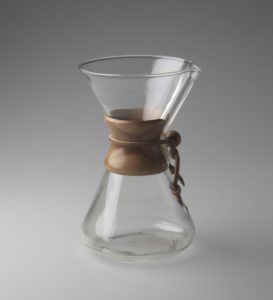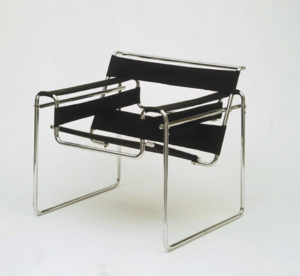
Peter Schlumbohm: Chemex Coffee Maker
It’s all around you, from the furniture at Ikea to the office buildings along Route 80 to the metal tube chairs in your office. If you had to give it a name, you might call it modern.
But where did it come from? Does this type of design even have a specific origin?
The answer is yes. What we call modern today had its roots in a German school that was started 90 years ago with an unusual purpose: to dissolve the boundary between fine arts and the crafts.
How this idea evolved and how this school, the Bauhaus, became such an influence on modern design is the story behind “Bauhaus 1919–1933: Workshops for Modernity” at the Museum of Modern Art.
The Modern is itself a direct descendent of this innovative school, but this is its first show on the Bauhaus since 1938. It recalls the Bauhaus for what it was, a school with a method and a mindset, rather than the way it is more commonly perceived — a movement armed with a new style.
The result is an exhibit filled with unexpected color, expressionist forms and other surprises. There are works by famous artist-teachers such as Paul Klee, Vasily Kandinsky, Lyonel Feininger, Josef Albers, and Oskar Schlemmer as well as ones by the some of the 1,250 students who were enrolled in the 14 years of the school’s existence.
You would never recognize the hand of Marcel Breuer in the rough-hewn, colorful “African Chair” that he made in 1921 with weaver Gunta Stölzl. The chair recently turned up after it was thought lost for 80 years. Breuer and Stolzl went on to become teachers, and Breuer to design minimalist steel tube furniture, such as his club chairs with their boxy open frames strung with taut bands of cloth.
The exhibit, which has more than 400 pieces, is organized chronologically, beginning with the school’s founding by Walter Gropius in 1919 in Weimar. Six years later it moved to Dessau to evade politically motivated attacks. In 1932, it relocated again, to Berlin. It was shut down by the Nazis a year later.

Wassily Chair by Marcel Breuer
Albers was another student turned teacher. The artist who would later become famous for painting compositions of different-colored nested squares, worked with grids of colored glass in the early 1920s. Like Breuer’s “African Chair,” and other Weimar pieces, these glowing checkerboards have a one-of-a-kind, handcrafted quality.
The drive to make objects of a simpler, more abstract design can be seen in the chess sets of Joseph Hartwig, the master craftsman of the Bauhaus wood workshop (every Bauhaus class was taught by both an artist and an artisan). Hartwig stripped away the figurative and military character of the pieces, turning knights, kings and bishops into blocks, spheres and triangles. The same trend can be seen in puppet design, from expressionistic puppets designed by Klee to the geometric puppets of Eberhard Schrammen and Kurt Schmidt.
After the move to Dessau, a factory town, Bauhaus workshops began turning out designs that could be mass-produced. This was an outgrowth of the idea that well-designed things should be simple and functional-looking. It also satisfied a utopian belief that good design should be affordable to everyone.
Of course, it hasn’t always worked out that way. A Marianne Brandt teapot made in a Bauhaus metal workshop has a crisp geometric design. It pays homage to the arc, circle and sphere, but its form was too complex to be industrially produced. Less than 10 were made and one of them sold at Sotheby’s in 2007 for $361,000.
The Nazi persecution of the Bauhaus – part of its campaign against what the party called “degenerate art” – backfired. After 1933, many Bauhaus teachers and students emigrated and spread the Bauhaus design ethic around the world, especially to the United States. This is why so many things in this exhibit – desk lamps, drop-leaf tables, glass-box buildings and others – have such a striking familiarity.

